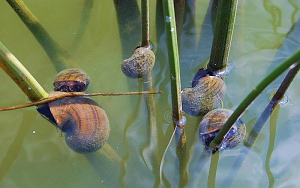Ebro Delta: Invasion of the Apple Snail
26 September 2010
 |
|
| Apple Snail | Source: Wikimedia |
Hundreds of thousands of snails that grow to the size of a golf ball are not only taking over and eating the Ebro delta rice fields but also threaten to destroy the delta ecosystem. At the moment, the snails have taken over the rice fields on the left bank, occupying a third of the 32,000 hectares of Natural Park, and have begun to spread to the other side.
In order to halt their advance and destroy them, the farmers
have applied the drastic measure of leaving 9,500 hectares of paddy fields dry
for six months instead of the usual three. The measures are supported by the
Ebro Delta Community authorities, which through its grants have forced the
fields to remain flooded through most of the year and thus promote the habitat
of migratory birds.
The economic losses are not significant at the moment, but rice farmers fear
serious consequences in the medium term if not remedied soon.
The ravages of Pomacea insularum, scientific name of the apple snail species
identified in the delta, were previously known only in countries of South
America and Asia. The snail is one of many invasive species located in the final
stretch of the Ebro and a Government report warns of the risk that "Delta
will become the gateway for invasive species of this kind in Europe."
At present, the rice farmers are in full harvest, which ends in the middle of
next month. After a margin of 10 days to prepare the ground, the field
drying is expected to start on 25 October. The measure changes the autumn
scenery of the delta, as it is usual to leave the land without water from 15
January to 15 April.
"The goal is to make the Delta totally clean of apple snails," says
Antoni Espanya, regional director of the Department of Agriculture in the Terres
de l'Ebre. "With this measure and others, we hope to create the most
unfavourable conditions for the survival of shellfish," he added.
Most of the plague is concentrated in about 100 hectares of the Left Bank. The
drying will occur mostly on this side, but is also likely to be implemented in
about 900 hectares on the right bank. Last year 4,000 hectares were left without
water for longer than usual, but the move did not deter the snails, which
reproduce with extraordinary rapidity in the mouths of canals and irrigated
fields.
Another measure is to change the field drains, because the snails find the best
living conditions in them. The measure will affect about 3,500 farmers and 6,000
plots. The farmers are required to install in each of them a new underground
pipe with a PVC elbow to impede the progress of the mollusc. In principle the
Government will subsidize 50% of the cost, but is considering increasing it to
70 or 80%.
